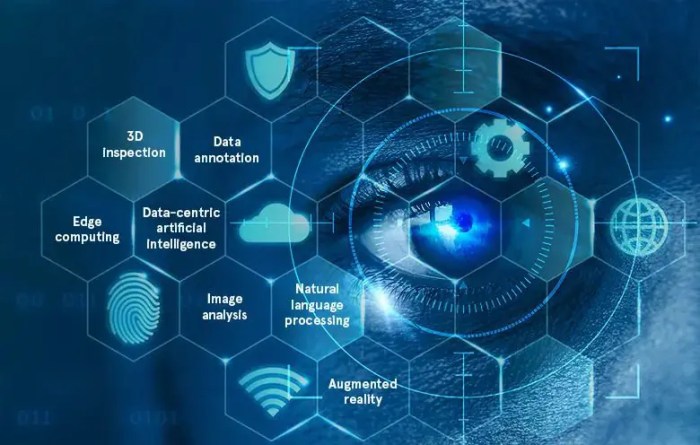Computer vision software development company – The field of computer vision is rapidly evolving, driving innovation across numerous industries. From autonomous vehicles and medical diagnosis to retail analytics and security systems, computer vision software is transforming how we interact with the world. This comprehensive guide explores the intricacies of computer vision software development companies, their roles, the technologies they employ, and the future of this exciting sector.
Understanding Computer Vision Software Development
Computer vision, a subfield of artificial intelligence (AI), empowers computers to “see” and interpret images and videos in a manner similar to humans. This involves complex processes of image acquisition, processing, analysis, and understanding. Computer vision software development companies specialize in building and deploying these sophisticated systems. They leverage various technologies and algorithms to achieve specific objectives, ranging from simple object detection to intricate scene understanding.
Core Technologies Used in Computer Vision Software Development
- Deep Learning: Convolutional Neural Networks (CNNs) are the backbone of many modern computer vision systems. These deep learning models excel at feature extraction and pattern recognition from images and videos. Companies often utilize frameworks like TensorFlow and PyTorch to build and train these models.
- Image Processing Techniques: Pre-processing steps like noise reduction, image enhancement, and segmentation are crucial for improving the accuracy and efficiency of computer vision algorithms. Companies employ various image processing libraries and tools for this purpose.
- Computer Vision APIs and SDKs: Cloud providers like Amazon Web Services (AWS), Google Cloud Platform (GCP), and Microsoft Azure offer pre-trained computer vision APIs and Software Development Kits (SDKs) that simplify the development process. These APIs provide access to powerful models for tasks such as object detection, facial recognition, and optical character recognition (OCR).
- 3D Computer Vision: This advanced area deals with understanding three-dimensional scenes from images or videos. It’s crucial for applications like robotics, augmented reality (AR), and autonomous driving. Techniques like stereo vision and structure from motion are commonly employed.
- Real-time Processing: Many computer vision applications, such as surveillance systems and robotics, require real-time processing capabilities. Companies optimize their algorithms and hardware to ensure low latency and high throughput.
The Role of Computer Vision Software Development Companies
Computer vision software development companies play a multifaceted role in bringing this technology to market. Their responsibilities extend beyond simply writing code; they encompass the entire lifecycle of a computer vision project:
Key Services Offered by Computer Vision Companies
- Custom Software Development: Tailoring computer vision solutions to specific client needs, often involving bespoke algorithm development and integration with existing systems.
- Data Acquisition and Annotation: Gathering and labeling large datasets of images and videos, a crucial step in training accurate deep learning models. This often involves human-in-the-loop processes for quality control.
- Model Training and Optimization: Developing, training, and fine-tuning computer vision models to achieve optimal performance on specific tasks. This involves experimenting with different architectures, hyperparameters, and training techniques.
- System Integration and Deployment: Integrating computer vision systems into existing infrastructure, deploying them on various platforms (cloud, edge devices), and ensuring seamless operation.
- Maintenance and Support: Providing ongoing maintenance, updates, and technical support to clients after deployment.
- Consulting Services: Advising clients on the feasibility, design, and implementation of computer vision projects, helping them choose the right technologies and strategies.
Choosing the Right Computer Vision Software Development Company
Selecting a suitable partner for your computer vision project requires careful consideration. Several factors should guide your decision:
Factors to Consider When Selecting a Company, Computer vision software development company
- Experience and Expertise: Look for companies with a proven track record in developing and deploying successful computer vision projects in your industry.
- Technical Capabilities: Assess their proficiency in relevant technologies, including deep learning frameworks, image processing techniques, and cloud platforms.
- Data Handling Capabilities: Ensure they have the expertise to manage large datasets, perform data annotation, and ensure data security and privacy.
- Project Management Skills: A well-structured project management process is crucial for successful project delivery. Inquire about their methodologies and track record.
- Communication and Collaboration: Effective communication is key to a successful partnership. Choose a company that prioritizes clear and regular communication.
- Pricing and Contract Terms: Understand their pricing model, payment terms, and contract conditions to avoid any surprises.
The Future of Computer Vision Software Development
The field of computer vision is poised for continued growth and innovation. Several trends are shaping its future:
Emerging Trends in Computer Vision
- Edge Computing: Processing computer vision tasks directly on edge devices (e.g., smartphones, cameras) reduces latency and dependence on cloud connectivity.
- Explainable AI (XAI): Increasing demand for transparency and understanding in AI systems is driving the development of methods to explain the decisions made by computer vision models.
- Synthetic Data Generation: Generating synthetic data to augment real-world datasets can address data scarcity issues and improve model robustness.
- Increased Use of 3D Computer Vision: Applications requiring precise spatial understanding, such as robotics and autonomous driving, will further fuel the development of 3D computer vision technologies.
- Integration with Other AI Technologies: Computer vision is increasingly integrated with other AI technologies like natural language processing (NLP) and speech recognition to create more sophisticated and intelligent systems.
Frequently Asked Questions (FAQ)
- Q: What are the common applications of computer vision?
A: Computer vision is used in a wide range of applications, including autonomous vehicles, medical image analysis, facial recognition, object detection, robotics, security surveillance, retail analytics, and more.
- Q: How much does it cost to develop a computer vision system?
A: The cost varies significantly depending on the complexity of the project, the required data, the chosen technologies, and the development team’s expertise. It’s best to get custom quotes from different computer vision companies.
- Q: What are the ethical considerations of computer vision?
A: Ethical concerns include bias in algorithms, privacy violations, misuse for surveillance, and potential job displacement. Responsible development and deployment are crucial to mitigate these risks.
- Q: What skills are needed to become a computer vision engineer?
A: A strong foundation in mathematics, computer science, and deep learning is essential. Proficiency in programming languages like Python, experience with deep learning frameworks (TensorFlow, PyTorch), and knowledge of image processing techniques are also vital.
References: Computer Vision Software Development Company
- Deep Learning by Goodfellow, Bengio, and Courville
- TensorFlow
- PyTorch
- Amazon Web Services (AWS) Computer Vision
- Google Cloud Vision API
Call to Action
Ready to leverage the power of computer vision for your business? Contact us today to discuss your project requirements and explore how we can help you achieve your goals. Let’s build the future of vision together!

Source: integrasources.com
General Inquiries
What are the typical costs associated with developing computer vision software?
Costs vary widely depending on project complexity, data requirements, and the level of customization. Expect a significant investment, ranging from tens of thousands to millions of dollars for larger-scale projects.
How long does it take to develop computer vision software?
Development timelines depend on project scope and complexity. Simple projects may take months, while larger, more intricate projects can take years to complete.
What types of industries benefit most from computer vision software?

Source: innosewa.com
Many industries benefit, including healthcare (medical imaging analysis), manufacturing (quality control), automotive (autonomous driving), security (surveillance systems), and retail (customer analytics).

Source: neubrain.in
What are the ethical considerations surrounding computer vision technology?
Ethical concerns include bias in algorithms, privacy violations, and the potential for misuse in surveillance and other sensitive applications. Responsible development and deployment are crucial.
